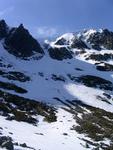Without doubt, the most celebrated gully descent in the Northeast of Scotland! The wide corridor of Black Spout is an obvious landmark in the corrie, cutting a deep line through the cliffs of Lochnagar.
Ideal conditions will be stable snow following considerable snowfall on Southwesterly or Westerly winds. The top of the gully can be heavily corniced, particularly skiers right. The easiest entry is usually skiers left, where there may be a shallow runnel allowing access. The upper section of the gully funnels into a narrow steep section. This is the crux of the descent. It's very short, and not that steep, but crucially, it can often be icy or bare. Once beyond that section, the gully widens to the junction with the left hand branch. There can often be a scoop in the snow here at the junction. The lower section of the gully is wide and quite easy angled.
Below the gully, you could continue all the way down to the loch, or if you wish to use your height to take out some of the distance across the corrie, stay high out of the bottom of Black Spout, crossing the snow cone below Raeburns Gully and descend the far side of that, aiming for the cairn and rescue box. From there you should be able to glide into the southern sector of the corrie.
It appears that Black Spout was skied from just below the cornice by Ashie Brebner... in 1954! You can read about it on page 26 of Issue 61 of the Scottish Mountaineer magazine (November 2013).
Approximate Start Height: 1130m
Approximate Descent: 280m
General Aspect: East
Climbing Grade: I
Notes: The top third is the most difficult, with the lower two thirds being much easier.








































